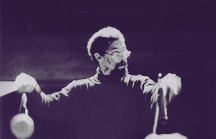

[ Metro | Metroactive Central | Archives ]
Sculpting Sound Musical Gestures: Jazzman Butch Morris conducts improvisations with a battery of hand movements.
Butch Morris brings context to improvisation
By Sam Prestianni
As composer, conductor and cornetist on nearly two dozen David Murray albums, Lawrence D. "Butch" Morris is a name familiar to most contemporary jazz fans. But nothing on those Murray collaborations compares to (or prepares one for) the magnitude of Morris' personal vision of "conduction," or conducted improvisation, archived on Testament: A Conduction Collection (New World Records), a 10-disc document of 15 out of 50 orchestral concerts directed on three continents over the past decade.
Born out of a desire to bring a structural flexibility to large-ensemble interaction, Morris uses a codified vocabulary of 18 gestures or hand signals to sculpt a "music of collective imagination." His system provides a focus for the musicmaking, yet it frees modern improvisers from the predetermined constrictions of the written page.
This liberation allows some of the top players of our time (such as J.A. Deane, Han Bennink, Myra Melford, Jemeel Moondoc, Ikue Mori) to tap the breadth of their creative reservoirs. It also maximizes the thrust of the music's energy while maintaining a dynamic equilibrium in its color, shape and texture. A union of intensities, the music on Testament surges ever forward as a metamorphic, multitentacled organism.
Morris' inchoate conduction theories were substantially inspired by his involvement in the all-night "energy orchestra" blowouts of New York City's loft scene in the mid-'70s. There, Morris connected with heavyweight collaborators like Murray and Frank Lowe. He also began to challenge "free-jazz" ideologies, reasoning that if he could somehow capture certain epic moments in the improvisations and reprise them later on, the music's range would be expanded profoundly.
By 1977, Morris had accepted teaching positions abroad. While leading workshops and university courses in Holland and Belgium, he gradually discovered how to put his innovative ideas into action. Unlike the conventional conductor, he was "looking to make music, not interpret it." But as music and method crystallized in his mind, one question lingered: What kind of music is this? His conclusion: "It is what it is."
Although the sound combinations on the album draw from jazz, classical and various world traditions, the music is neither and all of these. At times, it certainly swings like jazz, with what Morris calls "combustion and ignition," a fiery propulsion toward the suspense and surprise of the next moment. But not unlike classical music, Testament's selections cascade in giant sweeping movements--dramatic tsunamis and lush whitecaps.
Some of the most successful conductions took place in Istanbul and Tokyo, where old-world flavors of oud, koto, shakuhachi and harp meet new-world, electric-powered devices such as turntable, sampler, computer and drum machine. This startling fusion of opposites--acoustic/electric, soft/loud, nature/technology--resounds with an unexpected organic unity. Morris seems to channel and interconnect the primordial elements of earth, air, fire and water into an imagistic, almost video game-like animation. Communicating without words in a universal language, Butch Morris' conduction bridges the ancient to the future via the infinitely possible present.
[ Metro | Metroactive Central | Archives ] This page was designed and created by the Boulevards team.

Judy Sneed
From the March 28-April 3, 1996 issue of Metro
Copyright © 1996 Metro Publishing and Virtual Valley, Inc.